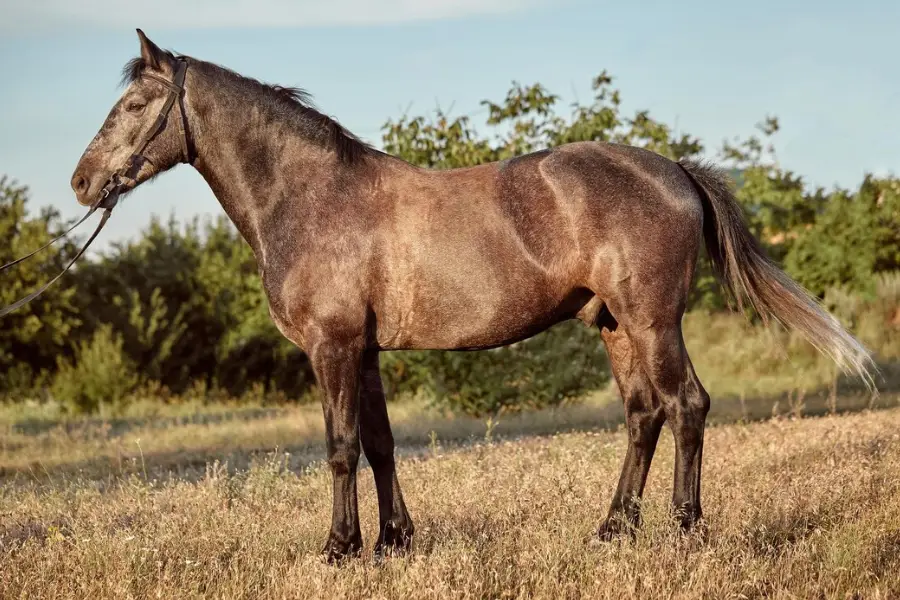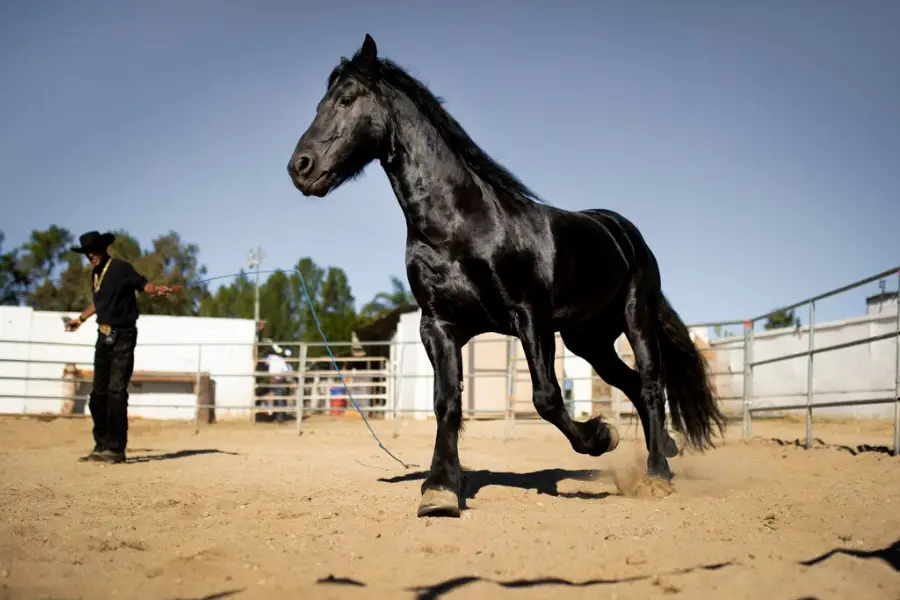How Much Does A Horse Weigh? Things You Should Know

How much does a horse weigh? Their weight is influenced by breed, age, diet, and exercise. These factors lead to differences in their sizes and weights. When horse owners know this information, they can have proper training programs and diet. It makes horses healthier and might reduce health problems. This article offers valuable insights into the average weight of horses and effective methods for measuring their weight.
The guide also mentions a chart to convert measurements into kg and pounds. Let’s read the article to learn the importance of a horse’s weight and its methods to keep a healthy weight.
Why Do Horse Owners Need To Control A Horse’s Weight?
Overweight or underweight horses can cause health issues. Owners should give frequent weight checks on the health and condition of horses. These may serve as precursors to possible health problems. In addition, a horse that maintains a healthy weight is more likely to enjoy a longer. Obesity can lead to joint issues. It can shorten your horse’s lifespan and diminish their quality of life. With frequent checks, you can make a balanced diet and fitness to avoid these risks for them.
How Much Does A Horse Weigh?

The average horse weight is between 50kg to 800kg. However, the weight a horse can pull might be over 1.5 times its weight when compared to its body. A horse’s weight can differ based on age, size, and breed. There are some distinct differences between a baby horse’s and an adult horse’s weights:
A Newborn Horse’s Weight
How much does a horse weigh in kg when horses are newborn? They might be 50 kg to 259 kg. A foal should weigh ten percent of its mother’s weight when it is born. If the mother weighs 600 kg, a foal can weigh 60 kg. A foal typically weighs between 50 kg to 150 kg. Foals can weigh between 100 kg to 259 kg when they reach six months.
An Adult Horse’s Weight
Horses vary widely in weight depending on horse breeds and sizes. For instance, light expensive horse breeds like the Quarter Horse typically weigh less than larger breeds. An average adult horse’s height is 160-170 cm. It is approximately 15.5-16.5 hands. Grown-up horses weigh between 1,102 to 1,323 pounds (500 to 600 kg). Draft horses can exceed 1,763 pounds (800 kg). Ponies are generally smaller. They often weigh between 771 to 992 pounds (350 to 450 kg).
A Horse’s Weight Relies On Height

There are general methods for estimating a horse’s weight based on its height. It offers approximate values rather than precise measurements. To get a more accurate estimate for horses, horse owners can refer to the chart provided below.
| Height at Withers | Weight in Kilograms | Weight in Pounds |
| 91 cm | 180 to 230 kg | 396 to 507 lbs |
| 101 cm | 230 to 270 kg | 505 to 595 lbs |
| 111 cm | 230 to 320 kg | 507 to 705 lbs |
| 121 cm | 230 to 360 kg | 507 to 792 lbs |
| 131 cm | 290 to 390 kg | 639 to 860 lbs |
| 141 cm | 350 to 460 kg | 771 to 1014 lbs |
| 151 cm | 410 to 540 kg | 904 to 1190 lbs |
| 161 cm | 480 to 710 kg | 1058 to 1565 lbs |
| 171 cm | 560 to 790 kg | 1235 to 1742 lbs |
A Horse’s Weight Relies On Breed
While height provides a general guideline, a horse’s breed can offer more specific insights into its weight range. Beautiful horse breeds have unique characteristics that influence their size and weight.
| Horse breed | Weight in Kilograms | Weight in Pounds |
| American Warmblood | 550 to 600 kg | 1213 to 1323 lbs |
| Hanoverian | 550 to 660 kg | 1213 to 1455 lbs |
| Cleveland Bay | 550 to 700 kg | 1213 to 1543 lbs |
| Heavyweight Hunter | 590 to 710 kg | 1298 to 1565 lbs |
| Gypsy | 580 to 730 kg | 1279 to 1607 lbs |
| Irish Draught | 600 to 810 kg | 1323 to 1786 lbs |
| Clydesdale | 700 to 810 kg | 1543 to 1786 lbs |
| Ardennais | 700 to 1010 kg | 1543 to 2225 lbs |
| Shire | 700 to 1200 kg | 1543 to 2645 lbs |
The Factors Affect Horse’s Weight

The management of a horse’s weight is crucial for tracking the horse’s health status. Therefore, owners must follow and understand the horse’s diet. Through some key factors, namely breed type, age, and individual health needs, the part will give you insights for better controlling the horse’s weight.
Horse’s breed type
Horse’s breed type is one of the key factors that affect the weight. Breeds like the Clydesdale and Percheron are designed for heavy labor with a heavyweight. The reason is that their large, muscular builds make them naturally heavier. Their weight often exceeds 1,800 pounds. They have broad chests, thick necks, and dense bones. Those also contribute to the horse’s considerable weight.
In contrast, warmblood horse breeds such as the Arabian or Thoroughbred are bred for speed and agility. They generally weigh between 900 to 1,200 pounds and are leaner.
Horse’s age
Their weight also depends on their age. Young horses often weigh approximately 100 pounds or more. However, their weight increases strongly because their body develops soon. The reason is that young horses need a diet rich in proteins, vitamins, and minerals to build strong bones and muscles. Grown-up horses weigh between 1102 and 1323 pounds. They require a large amount of food every day to be healthy.
Horse’s individual health needs
During their early years, foals and yearlings experience rapid growth. They demand a diet rich in essential nutrients. However, their health needs can significantly influence their weight. Young horses are prone to developmental disorders such as angular limb deformities and joint issues. A balanced diet rich in calcium, phosphorus, and protein supports healthy bone development.
Foals are particularly vulnerable to digestive disturbances like colic or diarrhea. It can lead to weight loss or hinder weight gain. Horse owners need to have a high-fiber diet and manage stressors in their environment for steady weight gain.
How To Measure The Horse’s Weight
There are two primary methods to measure a horse’s weight. Horse owners might consider weight tape and an equine scale. Here is a guide to two methods can be applied:
A Weight Tape
Step 1: Prepare the Horse
Your horse needs to be stood squarely on a flat and level surface. This will help you to get an accurate and consistent measurement.
Step 2: Position the Tape
Horse owners will start by placing the ‘zero’ end of the weight tape. The step needs to be measured at the lowest point of the horse’s withers. This is typically at the top of the horse’s shoulder. To define the position, horse owners can find behind the horse’s neck.
Step 3: Wrap the Tape
The step needs to gently bring the tape around the horse’s girth. This is the area just behind the front legs. The tape should pass behind the elbows and wrap snugly around the horse’s body.
Step 4: Read the Measurement
Pull the tape up so that the end meets the ‘zero’ point again. The tape will provide an approximate weight based on the girth measurement.
An Equine Scale
Step 1: Accessing the Scale
First, the step requires locating an equine scale. These scales are often found at veterinary clinics, boarding facilities, or specialized equine centers. Some facilities offer portable scales that can be used at home or shows. If you don’t have direct access to one, you may need to contact local equine professionals or facilities.
Step 2: Preparing Your Horse
Horse owners should keep their horses calm and comfortable. It is a good idea to familiarize your horse with the scale beforehand, if possible.
Step 3: Weighing the Horse
Guide your horse onto the scale. Horse owners need to make sure all four feet are evenly placed on the platform. The step will ensure the horse stands still while the scale measures its weight.
The management of a horse’s weight is crucial for their overall health and performance. Therefore, horse owners must follow and understand what benefits the horse’s diet. Through some key factors, namely breed type, age, and individual health needs, the part will give you insights for better controlling the horse’s weight.
FAQs
A horse’s weight relies on breed, age, and condition. The lowest weight of the horse is around 300 to 400 pounds (136 to 181 kilograms). For example, miniature horses have a low weight. They often weigh as little as 300 pounds (136 kilograms).
On the other end of the spectrum, draft horses are larger and more robust. They can weigh up to 2,200 pounds (1,000 kilograms) or more. Breeds such as the Clydesdale, Shire, and Percheron often have the highest weights. The heaviest draft horses can approach or even exceed 2,400 pounds (1,089 kilograms). Their weight might be different based on circumstances
You can weigh your horse every 2 to 4 weeks. This time is suitable for tracking changes and adjusting care as needed.
Final Thoughts
The reply to “How much does a horse weigh?” shows their health conditions. A horse’s weight reflects its breed, size, and condition. Their weight is influenced by a multitude of factors like diet, exercise, and health status. You have concerns about your horse’s weight and notice if your horse changes. You can consult with a veterinarian or an equine nutritionist to have a proper diet. By staying proactive and informed, you support your horse in leading a healthy, balanced, and fulfilling life.



